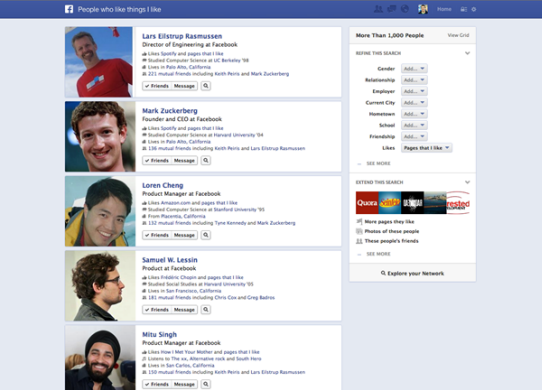Facebook Graph Search: What It Means For Your Brand?
This week, Mark Zuckerberg introduced Facebook’s new Graph Search feature. As an enhancement to the site’s current search feature, it leverages the power of a person’s social network to provide results that are more likely to be relevant to the user. When the feature completes its beta, it will be rolled out slowly to desktop users in the US. Graph Search will be focused on people, places, photos and interests, so if your brand fits in one of these categories, now is the time to prepare!
How does it work?
Facebook users can enter queries into the Facebook search box, such as “photos I like” or “restaurants near me” to get results that may potentially include brand pages. The search results are influenced by the searcher’s Facebook connections and the strength of these relationships. Users can use filters based on their social circle to narrow down the results and get the most relevant pages.
For example, this is what a user will see when searching for “People who like things I like”:
How does it differ from Google, Bing, and Yahoo searches?
Facebook envisions that people will use the Graph Search to find groups of people and places instead of websites. For example, if someone is using a regular search engine such as Google or Yahoo and searches the web for “Italian restaurant,” the search results page will include a variety of listings including local restaurants’ pages, review sites, media articles, etc.
Instead of searching for “Italian restaurant,” Facebook predicts users will use the Graph Search to look for “Italian restaurants my friends like,” and will then be served with results containing the Facebook pages of the restaurants that their friends have also liked.
Sponsored results have a big play here because in addition to showing results that your friends have liked, brands can also buy placements within these results. Forbes speculates that, though Graph Search doesn’t currently have ads, Facebook may eventually allow brands to purchase premium placement through sponsored results.
What does it mean for your brand and what actions should your brand take?
The Graph Search’s functionality means that your company will need to expand your Facebook presence by picking up more fans and truly engaging them. As your Facebook fan base grows, so does your brand page’s visibility. By the way, this may help you counter the negative effects of the Facebook Edgerank algorithm change rolled out last year.
Here are some actions that I recommend you considering now to ensure that your brand is ready for the Graph Search public release:
Make sure your Facebook page is up-to-date and complete with vanity URL, description, mailing address (if applicable), website URL and images.
Build a strong fan acquisition and retention strategy. Actively engage your Facebook audience through daily posts, contests, surveys, etc.
Make sure the content posted to your brand’s Facebook page is of good quality and relevance.
If budget allows, buy a sponsored ad for your page to increase the number of “likes.”
Another important thing to note is that Bing serves as the backup search engine if there is nothing to match the user’s query on Facebook. So, optimizing your main brand website for Bing can eventually help you earn organic search traffic from Facebook’s Graph Search.
The use of Bing is interesting. While it is one of the top three search engines, Bing’s share of organic search is still at only about 16% – miniscule compared to Google which owns about 66% of all organic searches. The Facebook/Bing partnership might be Microsoft’s biggest play in positioning Bing as a major player in the search industry, so this is something to keep an eye on.
If you haven’t already, you can preview the Facebook Graph Search and sign up for a beta version. More details from Facebook on Graph Search can also be found in the official press release.
What do you think about this news? I’m very curious to see how this pans out!




